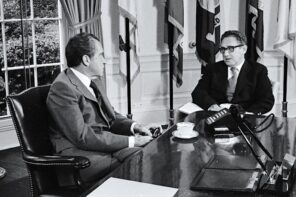In early April, the internet was entranced by televangelist Kenneth Copeland summoning the wind of God to destroy coronavirus: “I blow the wind of God on you. You are destroyed forever, and you’ll never be back.” On April 20, a video taken by CNN reporter Miguel Marquez from an anti-lockdown protest in Harrisburg, Virginia, spread around Twitter. In front of the Pennsylvania State Capitol was a green truck with “JESUS IS MY VACCINE” written on the side, “FREEDOM IS NOT FOR SALE” on the hood, and sporting three different types of flags: the Stars and Stripes, the Gadsden flag (AKA “Don’t Tread On Me”), and a depiction of Trump holding a grenade launcher. Not long after, Liberty Counsel, a Christian ministry and law firm, started the hashtag #ReOpenChurchSunday, calling for all churches across the U.S. to reopen on May 3rd in time to prepare for the National Day of Prayer later that week.
All of these actions have something in common: They’re built on the belief that God is guiding America’s history, that surrendering to Jesus will bring spiritual salvation even if your body is sick and dies, and that the government and epidemiologists cannot be trusted to get the job done. Many of these claims are common among conservative Christians in the U.S. whose concern for vaccination and public health coincides with distrust in medical professionals and human authority. Christian distrust in the scientific community and governmental authorities is, of course, nothing new. But my recent research on an early Christian preacher has clarified just how deep Christian distrust of medicine and medical professionals goes—as well as its antisemitic hue.
Before his ascent to become Archbishop of Constantinople in the newly-formed Byzantine Empire, John Chrysostom was a preacher in his hometown of Antioch (modern Antakya, Turkey). Early on in his career as a priest, Chrysostom produced a famous series of eight sermons that were mostly given over a one-month period toward the end of the 4th century CE, now known as the Homilies Against the Jews.
In her book Slandering the Jew: Sexuality and Difference in Early Christian Texts, Susanna Drake, professor of religious studies at Macalester College, explored how Chrysostom sexually stereotyped Jewish men as weak and effeminate, women as prostitutes, and the synagogue as a brothel in his first two Homilies. Chrysostom intended to turn Christians away from associating with Jewish people and spaces. Jews were depicted by Chrysostom as a disease against which his words were a cure—a cure that protected the health of the body of the church and the body of Christ.
As scholars of early Christianity and early Judaism have recognized over the last few decades, Jews and Christians held similar beliefs and practices throughout the first few centuries CE, and Christians often bent over backwards to distinguish themselves from their Jewish counterparts. Early Christian authors like Chrysostom, Drake notes, often imagined Jews and “judaizers” (Christians who participate in some form of Jewish practice) to be simultaneously aggressive toward innocent Christians and “softies” who failed to uphold gendered and familial hierarchies.
Most of the Homilies Against the Jews were written and delivered in church by Chrysostom in order to discourage his congregants from attending Jewish festivals like Rosh Hashanah, Yom Kippur, and Sukkot. Even well into the fourth century, there was no clear divide between “Jew” and “Christian” in Antioch. Congregants of Chrysostom’s church continued to populate the synagogue and participate in Jewish ritual practices, much to his dismay. As the need for a month-long sermon series suggests, Chrysostom was not immediately successful. Every week, he tried to convince his Christian congregants—or, at least, those who actually showed up to church—that Jewish practices and spaces were unacceptable for a Christ-follower. He constantly asked those present to go out and wrangle up those who weren’t listening to him.
My research, focused on Homily 8, suggests that Chrysostom was not only worried about Christian congregants attending Jewish festivals and inhabiting Jewish spaces, but also about Christians seeking out Jewish healers and healing practices. (Tongue in cheek, I’ve called Chrysostom the first Christian anti-vaxxer.) In short, Chrysostom was anxious that congregants who went to Jews in Antioch for healing would abandon his church and, likewise, his (Christian) God.
The boundaries between Christian, Jew, and pagan in fourth-century Antioch were anything but stable. Scholars find it difficult to determine whether an object used for healing or cursing (e.g., , amulets, spells, incantations, curse tablets) fit into one of those three specific boxes that we now call “religions.” Those boundaries were blurred, and people tended to seek out help not only from whatever traditions they associated with, but from practices that were most efficacious.
For example, a recently uncovered curse tablet from Antioch calls on the god Iao to strike down a greengrocer named Babylas just as Iao struck down the chariot of Pharaoh and cut down the firstborn of Egypt, alluding to narratives from the book of Exodus. However, as Alexander Hollmann, the editor of the curse tablet, suggests, the curse is not necessarily Jewish. Greek and Roman magic often incorporated Jewish and Egyptian texts and figures that were deemed efficacious. If a deity got the job done, you could call on it.
Chrysostom knew of local Christians seeking out healers, amulets, incantations, and more. In his other sermons, he explicitly challenges women who marked their children’s foreheads with mud in order to keep away the evil eye, offering instead the sign of the cross as a symbol of protection. Chrysostom rebuked women and children who wore mini-versions of the Gospels as amulets around their neck, suggesting that speaking passages from the Gospels was more effective than any amulet—even one that contained those same words. Chrysostom reproached those who encircled themselves with golden coins of Alexander the Great in order to bring good luck and health, since putting trust in Alexander was—as Chrysostom argued—putting one’s faith in a dead man rather than the “true” Alexander: Jesus Christ.
This fuzziness between which practices were “Christian,” “Jewish,” or “pagan” caused Chrysostom anxiety in Homily 8, leading him to preach a playbook. Following his play-by-play, Chrysostom’s congregants could take his message, go out into the city, and reclaim Christians who were judaizing and endangering both their own bodies and the body of the church with Jewish “impurity.” Not only were Jews metaphorically illnesses to Chrysostom, but they could physically cause even worse illnesses of the body and soul through their incantations, amulets, charms, and spells.
As part of Chrysostom’s homiletic playbook, he suggested that it was better for Christians to die of a fever rather than to seek medicine or healing—not only from Jewish healers, but from any healer. To die while avoiding Jewish healers was deemed a perfect martyrdom, after which Jesus Christ would lead the fevered martyr hand-in-hand around heaven and boast of their willingness to suffer like Job, Lazarus, and Timothy.
Just as he associated Jews with illness, weakness, and effeminacy, Chrysostom associated Christians—specifically, Christians who refused to judaize—with masculinity, athleticism, piety, and (spiritual) health. As Chrysostom claimed: No fever burns you as much as the fire of Gehenna, and no temporary healing is worth your soul; A true martyr suffers through illness and is loved by God for not succumbing to the pressures and (Jewish) impurities of this world.
Of course, writing “JESUS IS MY VACCINE” on a concrete truck does not evoke the entirety of Chrysostom’s antisemitic and vitriolic rhetoric that sought to distinguish Christians from Jews. But it’s part of a longer history of associating physical sickness with spiritual strength, scapegoating groups of people as the vectors of disease, and distrusting institutions deemed non-Christian for health and healing.
Such rhetoric should sound very familiar in the midst of the coronavirus pandemic. Some neo-charismastic Christians are defying public health measures, and many white nationalists are grasping for a masculinist Christian social order that views the scientific community as an enemy to Christian values. Others view public health measures through an apocalyptic lens, claiming that the government is functioning like Caesar and oppressing Christians’ ability to practice their religion or to prepare themselves for the arrival of the Antichrist—a figure understood to come in the midst of the apocalyptic chaos.
In a different Antioch (California), a planning commission member was fired for suggesting on Facebook that coronavirus ought to weed out the weak like a controlled forest fire, playing into long-standing rhetoric that only the strong deserve to survive. Such Christians view the pandemic as an opportunity to prove their worth to Christ, often through similar language to Chrysostom regarding their masculinity, independence, preference of the spiritual over the physical, and willingness to die for God.
Of course this antagonistic relationship between Christ-followers and healthcare isn’t the only way that early Christians approached health and healing, and it certainly doesn’t need to be the only way for conservative Christians today. For example, early Christian missionaries often understood themselves to function like traveling physicians. Late ancient Christian monasteries functioned as a template for the development of hospitals as an institution that cared for the sick. The apocryphal Acts of Peter and the Twelve Apostles even depicts Christ in the form of an angel named Lithargoel, who gives each of the apostles pouches of medicine and commands them to heal people’s physical bodies, so that then the apostles will be trusted to heal their spiritual illnesses. While early Christians agreed that the physical self and the spiritual self were distinct, not all Christians followed Chrysostom’s claim that it’s better to die of a fever if you want to prove your worth to God.
Rather than viewing vaccinations, public health mandates, and medical professionals as an enemy, there is precedent for Christians to participate in a different tradition—one that values physical health and posits Christians as those who care deeply for the ill. As Pastor Terri Horn of Le Sueur UMC in Minnesota so aptly put it: “Daring Christ to save you is quite another [thing]. It is jumping off a cliff in the desert. Even Jesus refused to do that. Tempting fate is not filled with faith, nor is it a vaccine.” Jesus isn’t the vaccine to COVID-19, but he can inspire concern for the health of those around us who are ill, at risk, mourning, and those deemed “essential” enough to be sacrificed—unwilling martyrs for the economy.





